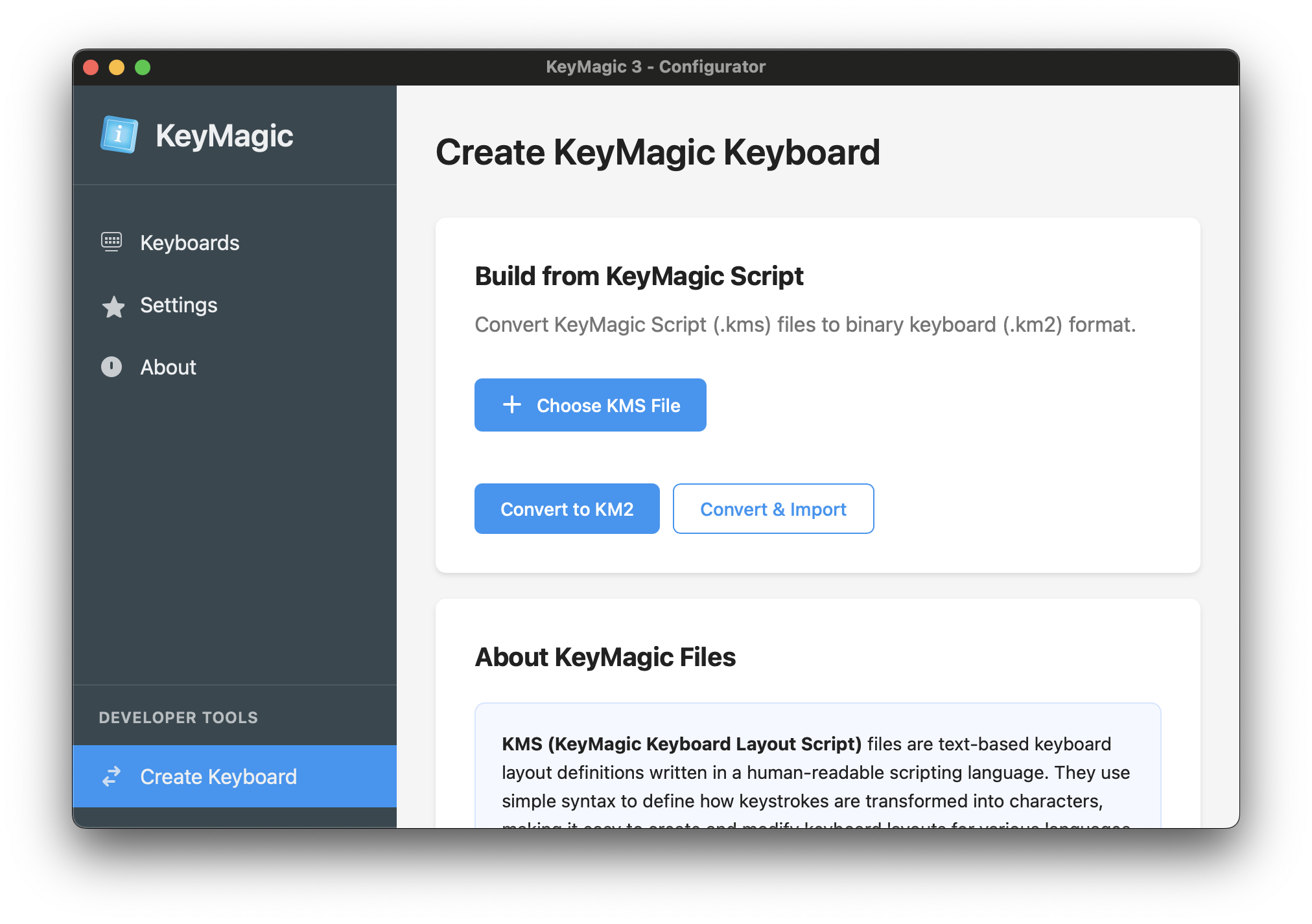KMS to KM2 Conversion Guide
Converting KMS to KM2 Using KeyMagic Configurator
Overview
KeyMagic keyboards come in two formats:
- KMS Files (.kms): Text-based keyboard scripts that define typing rules
- KM2 Files (.km2): Compiled binary keyboards that KeyMagic uses
This guide shows how to convert KMS files to KM2 format using the KeyMagic Configurator.
Steps to Convert
Step 1: Open KeyMagic Configurator
Launch KeyMagic 3 Configurator from:
- Windows: Start Menu or system tray
- macOS: Applications folder or Launchpad
- Linux: Application menu
Step 2: Go to Create Keyboard
Click Create Keyboard in the Developer Tools section (bottom of the left sidebar).

Step 3: Choose Your KMS File
Click the Choose KMS File button to browse and select your .kms script file.
Once selected:
- The file name will appear below the button
- The converter will validate the file
- The action buttons will become enabled
Step 4: Select an Action
After selecting your KMS file, choose one of two options:
Convert to KM2
- Purpose: Creates a KM2 file and saves it to your chosen location
- Steps:
- Click Convert to KM2
- Choose where to save the file
- The compiled KM2 file will be saved
- Use when: You want to share the keyboard or keep the file for later
Convert & Import
- Purpose: Creates a KM2 file and immediately adds it to KeyMagic
- Steps:
- Click Convert & Import
- The keyboard is compiled and imported automatically
- It appears in your Keyboards list ready to use
- Use when: You want to start using the keyboard right away
Understanding the Results
Successful Conversion
When conversion succeeds:
- ✅ A success message appears
- The KM2 file is created
- For “Convert & Import”: The keyboard appears in your Keyboards list
Conversion Errors
If conversion fails, you’ll see:
- ❌ An error message with details
- The line number where the error occurred
- A description of what went wrong
Common errors:
- Syntax error: Check for typos in your KMS file
- Missing file: Ensure referenced icons exist
- Invalid Unicode: Verify character codes are correct
What Happens During Conversion
The converter:
- Reads your KMS text file
- Validates all syntax and rules
- Compiles rules into optimized binary format
- Packages everything into a KM2 file
- Reports success or any errors found
Platform Note
The converter works identically on Windows, macOS, and Linux. KM2 files created on any platform work on all others.
Quick Tips
- Keep your original KMS files - you’ll need them to make changes
- The converter shows clear error messages if something goes wrong
- Use “Convert & Import” for quick testing of your keyboards
- Use “Convert to KM2” when preparing keyboards to share
Next Steps
After converting:
- Test your keyboard: Switch to it and try typing
- Check the Keyboards page: Your imported keyboards appear there
- Make changes: Edit the KMS file and convert again if needed
Learning to Write KMS Files
If you’re interested in creating or modifying KMS keyboard scripts:
- Example keyboards: Browse existing KMS files at github.com/thantthet/keymagic-keyboards
- Learn by example: Study how existing keyboards implement their rules
- Start simple: Modify an existing keyboard before creating one from scratch